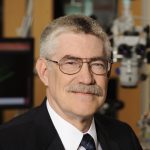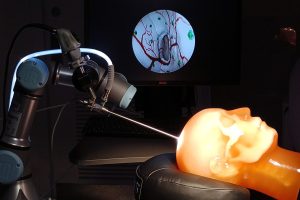In robotics, our expertise ranges from minimally invasive surgical robots to the integration of robots into human environments to support daily tasks. Our computer vision group focuses on research in recognition, detection, medical imaging analysis, and computer vision for augmented reality. In graphics, our strengths include shape retrieval, symmetry detection, surface reconstruction, mesh editing, and image processing.
We collaborate often with the university’s Laboratory for Computational Sensing and Robotics, widely regarded as one of the top robotics research sites in the world—particularly in the area of medical robotics.
Research Groups and Labs
Computational Interaction and Robotics Lab
CIRL researchers are interested in understanding problems that involve dynamic, spatial interaction at the intersection of vision, robotics, and human-computer interaction.
Computer Aided Medical Procedures
The CAMP lab aims to develop next-generation solutions for computer-assisted interventions, by studying, modeling, and monitoring surgical workflows to enable the development of novel patient- and process-specific imaging and visualization methods.
Computer Graphics Group
The Johns Hopkins Computer Graphics Group investigates shape retrieval, symmetry detection, surface reconstruction, mesh editing, and image processing.
Intuitive Computing Laboratory
The Intuitive Computing Laboratory focuses on designing and building intuitive interaction capabilities for computing and robotics technologies to be integrated into human environments to enhance supported task performance and user experience.
Laboratory for Computational Sensing and Robotics
The LCSR is a locus for robotics research, covering domains from computer-integrated medicine to human-computer interaction to robotic deep sea exploration.
Medical UltraSound Imaging and Intervention Collaboration Research Laboratory
The MUSiiC Research Laboratory conducts research on advanced ultrasound techniques, including ultrasound elastography imaging, 3D ultrasound reconstruction methods, parallel and GPU implementations, CT-US registration, and segmentation.
People
-
 Email:hager@jhu.eduPhone:(410) 516-5521
Email:hager@jhu.eduPhone:(410) 516-5521
-
 Email:chienming.huang@jhu.eduPhone:(410) 516-4537
Email:chienming.huang@jhu.eduPhone:(410) 516-4537
-
 Email:craigj@jhu.edu
Email:craigj@jhu.edu
-
 Email:pkaz@jhu.eduPhone:(410) 516-5590
Email:pkaz@jhu.eduPhone:(410) 516-5590
-
 Email:mkazhda1@jhu.eduPhone:(410) 516-0060
Email:mkazhda1@jhu.eduPhone:(410) 516-0060
-
 Email:ssaria1@jhu.eduPhone:(410) 516-4126
Email:ssaria1@jhu.eduPhone:(410) 516-4126
-
 Email:tianmin.shu@jhu.edu
Email:tianmin.shu@jhu.edu
-
Russell Taylor
John C. Malone Professor Email:rht@jhu.eduPhone:(410) 516-4639
Email:rht@jhu.eduPhone:(410) 516-4639
-
 Email:mathias@jhu.eduPhone:(410) 516-4253
Email:mathias@jhu.eduPhone:(410) 516-4253
-
 Email:ayuille1@jhu.eduPhone:(410) 516-5331
Email:ayuille1@jhu.eduPhone:(410) 516-5331
Navigational technology used in self-driving cars aids brain surgery visualization
Johns Hopkins researchers demonstrate the promise of “augmented endoscopy,” a real-time neurosurgical guidance method that uses advanced computer vision techniques.
